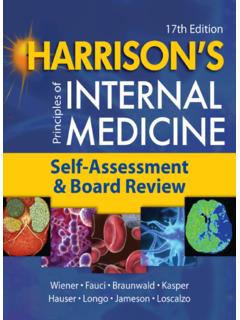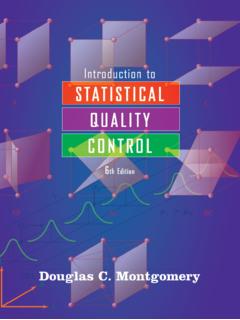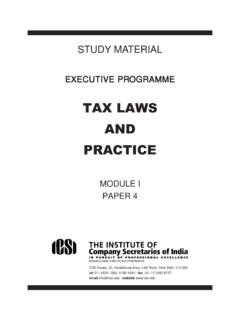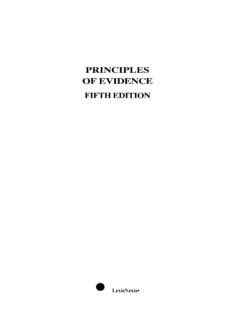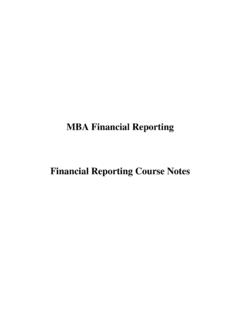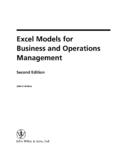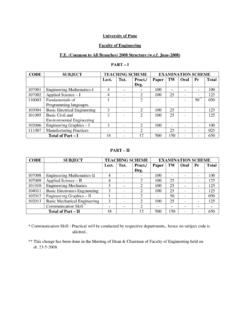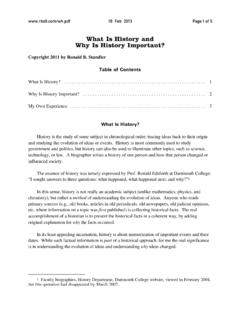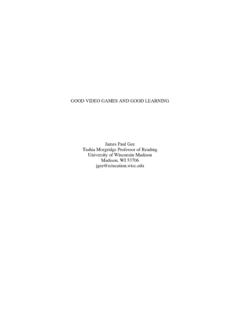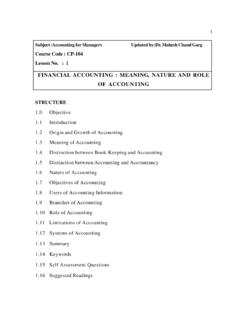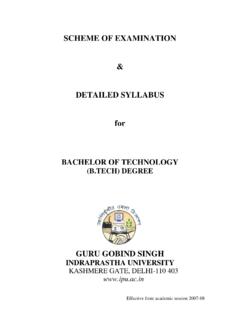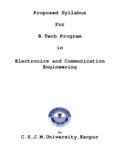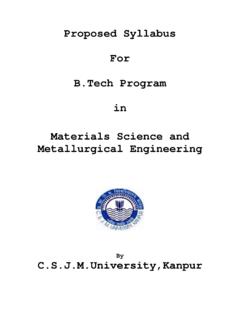Transcription of Fundamentals of Materials Science and …
1 Fundamentals of Materials Science and EngineeringAn Interactivee TextFIFTHEDITIONF undamentals of MaterialsScience and EngineeringAn Interactivee TextWilliam D. Callister, of Metallurgical EngineeringThe University of UtahJohn Wiley & Sons, YorkChichesterWeinheimBrisbaneSingaporeT orontoFront Cover:The object that appears on the frontcover depicts a monomer unit for polycarbonate (orPC, the plastic that is used in many eyeglass lensesand safety helmets). Red, blue, and yellow spheresrepresent carbon, hydrogen, and oxygen atoms, Cover:Depiction of a monomer unit forpolyethylene terephthalate (or PET, the plastic usedfor beverage containers). Red, blue, and yellowspheres represent carbon, hydrogen, and oxygenatoms, AndersonMarketing ManagerKatherine HepburnAssociate Production DirectorLucille BuonocoreSenior Production EditorMonique CalelloCover and Text DesignerKarin Gerdes KincheloeCover IllustrationRoy WiemannIllustration StudioWellington StudioThis book was set in 10/12 Times Roman byBi-Comp, Inc.
2 , and printed and bound byVon Hoffmann Press. The cover was printed byPhoenix Color book is printed on acid-free paper. The paper in this book was manufactured by amill whose forest management programs includesustained yield harvesting of its yield harvesting principles ensure thatthe number of trees cut each year does not exceedthe amount of new 2001, John Wiley & Sons, Inc. Allrights part of this publication may be reproduced,stored in a retrieval system or transmitted in anyform or by any means, electronic, mechanical,photocopying, recording, scanning or otherwise,except as permitted under Sections 107 or 108 ofthe 1976 United States Copyright Act, withouteither the prior written permission of the Publisher,or authorization through payment ofthe appropriate per-copy fee to the CopyrightClearance Center, 222 Rosewood Drive, Danvers,MA 01923, (508) 750-8400, fax (508) to the Publisher for permission shouldbe addressed to the Permissions Department,John Wiley & Sons, Inc.
3 , 605 Third Avenue,New York, NY 10158-0012, (212) 850-6011,fax (212) 850-6008,e-mail: order books or for customer service call1-800-CALL-WILEY (225-5945).ISBN 0-471-39551-XPrinted in the United States of America10987654321 DEDICATED TO THEMEMORY OFDAVIDA. STEVENSONMYADVISOR,ACOLLEAGUE,AND FRIEND ATSTANFORDUNIVERSITYP refaceFundamentals of Materials Science and Engineeringis an alternate version ofmy text, Materials Science and Engineering: An Introduction, Fifth of both are the same, but the order of presentation differs andFundamen-talsutilizes newer technologies to enhance teaching and regard to the order of presentation, there are two common approachesto teaching Materials Science and engineering one that I call the traditional approach, the other which most refer to as the integrated approach.
4 With thetraditional approach, structures/characteristics/properties of metals are presentedfirst, followed by an analogous discussion of ceramic Materials and , Fifth Editionis organized in this manner, which is preferred by manymaterials Science and engineering instructors. With the integrated approach, oneparticular structure, characteristic, or property for all three material types is pre-sented before moving on to the discussion of another structure/characteristic/prop-erty. This is the order of presentation the most common criticism of college textbooks is that they are toolong. With most popular texts, the number of pages often increases with each newedition. This leads instructors and students to complain that it is impossible to coverall the topics in the text in a single term.
5 After struggling with this concern (tryingto decide what to delete without limiting the value of the text), we decided to dividethe text into two components. The first is a set of core topics sections of thetext that are most commonly covered in an introductory Materials course, andsecond, supplementary topics sections of the text covered less frequently. Fur-thermore, we chose to provide only the core topics in print, but the entire text(both core and supplementary topics) is available on the CD-ROM that is includedwith the print component as to which topics to includein print and which to include only on the CD-ROM were based on the results ofa recent survey of instructors and confirmed in developmental reviews.
6 The resultis a printed text of approximately 525 pages and anInteractive eTexton the CD-ROM, which consists of, in addition to the complete text, a wealth of additionalresources including interactive software modules, as discussed text on the CD-ROM with all its various links is navigated using AdobeAcrobat . These links within theInteractive eTextinclude the following: (1) fromthe Table of Contents to selectedeTextsections; (2) from the index to selectedtopics within theeText;(3) from reference to a figure, table, or equation in onesection to the actual figure/table/equation in another section (all figures can beenlarged and printed); (4) from end-of-chapter Important Terms and Conceptsto their definitions within the chapter; (5) from in-text boldfaced terms to theircorresponding glossary definitions/explanations; (6) from in-text references to thecorresponding appendices; (7) from some end-of-chapter problems to their answers.
7 (8) from some answers to their solutions; (9) from software icons to the correspond-ing interactive modules; and (10) from the opening splash screen to the supportingweb interactive software included on the CD-ROM and noted above is the samethat accompaniesIntroduction, Fifth software,Interactive MaterialsScience and Engineering, Third Editionconsists of interactive simulations and ani-mations that enhance the learning of key concepts in Materials Science and engi-neering, a Materials selection database, andE-Z Solve: The Engineer s EquationSolving and Analysis components are executed when the user clickson the icons in the margins of theInteractive eText;icons for these several compo-nents are as follows:Crystallography and Unit CellsTensile TestsCeramic StructuresDiffusion and Design ProblemPolymer StructuresSolid Solution StrengtheningDislocationsPhase DiagramsE-Z SolveDatabaseMy primary objective inFundamentalsas inIntroduction, Fifth Editionis topresent the basic Fundamentals of Materials Science and engineering on a levelappropriate for university/college students who are well grounded in the fundamen-tals of calculus, chemistry, and physics.
8 In order to achieve this goal, I have endeav-ored to use terminology that is familiar to the student who is encountering thediscipline of Materials Science and engineering for the first time, and also to defineand explain all unfamiliar second objective is to present the subject matter in a logical order, fromthe simple to the more complex. Each chapter builds on the content of previous third objective, or philosophy, that I strive to maintain throughout the textis that if a topic or concept is worth treating, then it is worth treating in sufficientdetail and to the extent that students have the opportunity to fully understand itwithout having to consult other sources. In most cases, some practical relevance isprovided.
9 Discussions are intended to be clear and concise and to begin at appro-priate levels of fourth objective is to include features in the book that will expedite thelearning process. These learning aids include numerous illustrations and photo-graphs to help visualize what is being presented, learning objectives, WhyStudy .. items that provide relevance to topic discussions, end-of-chapter ques-tions and problems, answers to selected problems, and some problem solutions tohelp in self-assessment, a glossary, list of symbols, and references to facilitateunderstanding the subject fifth objective, specific toFundamentals,is to enhance the teaching andlearning process using the newer technologies that are available to most instructorsand students of engineering of the problems inFundamentalsrequire computations leading to numeri-cal solutions; in some cases, the student is required to render a judgment on thebasis of the solution.
10 Furthermore, many of the concepts within the discipline ofviii PrefacePreface ixmaterials Science and engineering are descriptive in nature. Thus, questions havealso been included that require written, descriptive answers; having to provide awritten answer helps the student to better comprehend the associated concept. Thequestions are of two types: with one type, the student needs only to restate in his/her own words an explanation provided in the text material ; other questions requirethe student to reason through and/or synthesize before coming to a conclusionor same engineering design instructional components found inIntroduction,Fifth Editionare incorporated of these are in Chapter 20, Materials Selection and Design Considerations, that is on the CD-ROM.
